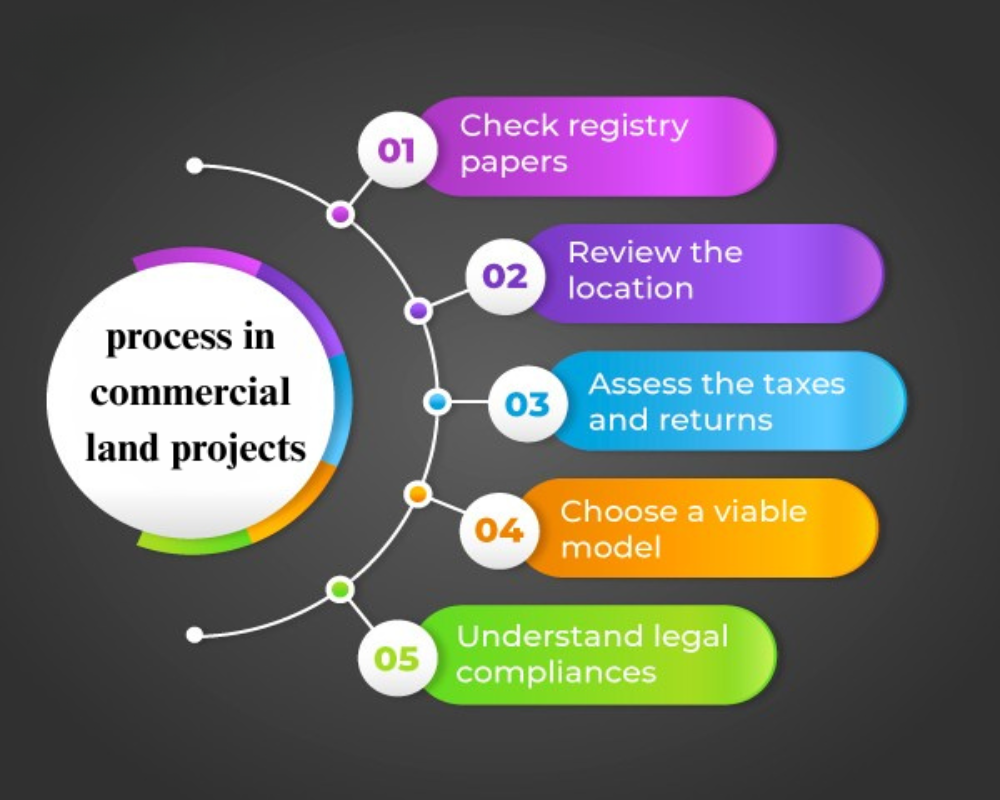Introduction
The build-to-suit process in commercial land projects is a development model where a property owner or developer constructs a commercial building specifically tailored to the needs of a single tenant or buyer. Unlike speculative development, where buildings are constructed without a specific occupant in mind, build-to-suit projects are customized from the ground up. This model offers significant advantages to both parties: tenants get purpose-built facilities that match their operational requirements, while landowners secure long-term occupancy and rental stability. Build-to-suit is commonly used in retail, warehousing, logistics, corporate offices, and healthcare facilities.
Land Selection and Tenant Requirement Analysis
The process begins with identifying and securing a suitable parcel of land. Location, zoning, access, utilities, and visibility are critical considerations. Simultaneously, the prospective tenant provides detailed operational, spatial, and technical requirements. These may include size, layout, loading docks, ceiling height, parking needs, and energy efficiency. The project is shaped around the tenant’s specifications, making accurate requirement analysis essential for feasibility and design.
Feasibility Study and Site Evaluation
Once land and requirements are aligned, the developer conducts a feasibility study. This includes cost estimation, site evaluation, legal due diligence, and zoning compliance checks. Soil testing, access to utilities, environmental clearance, and development regulations are also examined. The feasibility phase confirms that the site can accommodate the tenant’s needs and that the project is financially and technically viable.
Design Development and Custom Planning
In the design phase, architects and engineers work with the tenant to create a customized building plan. Layouts are prepared to optimize workflow, customer access, logistics, and energy systems. The tenant often reviews and approves every stage, ensuring the final structure matches their brand, function, and expansion goals. This collaborative design process enhances operational efficiency and long-term satisfaction.
Lease Agreement or Sale Contract Execution
With a finalized design and approved plan, legal agreements are signed. In most cases, the project proceeds under a long-term lease model (e.g., 10 to 20 years). The lease agreement defines rental rates, escalation clauses, fit-out responsibilities, and handover timelines. Alternatively, in a build-to-sell scenario, a purchase contract is signed with milestone-based payments. These contracts are foundational to construction financing and developer commitment.
Permitting and Approvals
The developer then applies for construction permits, layout approvals, fire safety clearances, and utility connections. Since the building is customized, timely coordination with government agencies is crucial. Any delay in approvals can affect construction timelines and tenant operations. A build-to-suit process often requires accelerated permitting schedules and pre-approval coordination.
Construction and Project Management
With permits in place, site work and construction begin. Timelines are strictly monitored since delivery dates are contractually committed. Developers often use experienced project managers to coordinate vendors, suppliers, and contractors. Construction follows tenant-approved specifications, ensuring the end result meets performance and design expectations. Progress reviews and inspections may involve tenant representatives.
Tenant Fit-Out and Handover
After core construction, tenant-specific fit-outs such as interior partitions, lighting, equipment installation, and signage are completed. Depending on the agreement, either the developer or the tenant handles fit-outs. Once all work is complete, final inspections are conducted, and possession is formally handed over to the tenant. A detailed checklist ensures everything meets quality and contract standards.
Occupancy and Lease Commencement
Following handover, the tenant begins occupying the building and operating their business. Rent commencement typically starts upon handover or after a defined fit-out period. In case of a build-to-sell, ownership transfer is completed during this stage. Occupancy marks the beginning of the income stream for the landowner or developer, validating the project’s financial return.
Post-Occupancy Support and Maintenance
Depending on the lease terms, the developer may continue to manage building maintenance, utilities, landscaping, and security. In triple net leases, the tenant assumes full responsibility. Regular performance audits and facility support ensure that the building continues to serve the tenant effectively. Post-occupancy support strengthens tenant relations and long-term stability.
Exit or Renewal Strategy
At the end of the lease period, options such as renewal, buyout, or redevelopment are evaluated. A satisfied tenant may negotiate a lease extension or purchase the property outright. If the tenant exits, the developer can lease the building to a similar business or retrofit it for new use. The exit strategy is planned early, ensuring the long-term commercial value of the asset.
Conclusion
The build-to-suit process in commercial land projects offers a structured, customized, and collaborative approach to property development. It reduces tenant risk, guarantees occupancy for developers, and ensures maximum space utilization. From land acquisition and design to construction and tenant move-in, every step is aligned with the end-user’s needs. When managed professionally, build-to-suit projects create durable real estate assets, stable rental income, and long-term business relationships.
Hashtags
#BuildToSuit #CommercialRealEstate #LandDevelopment #CustomConstruction #RealEstateInvestment #PropertyDevelopment #CommercialProjects #TailoredSolutions #SiteSelection #ConstructionProcess #BusinessGrowth #RealEstateTrends #InvestmentOpportunities #UrbanDevelopment #CommercialSpaces #DesignBuild #ProjectManagement #RealEstateStrategy #ClientFocused #CommercialArchitecture




